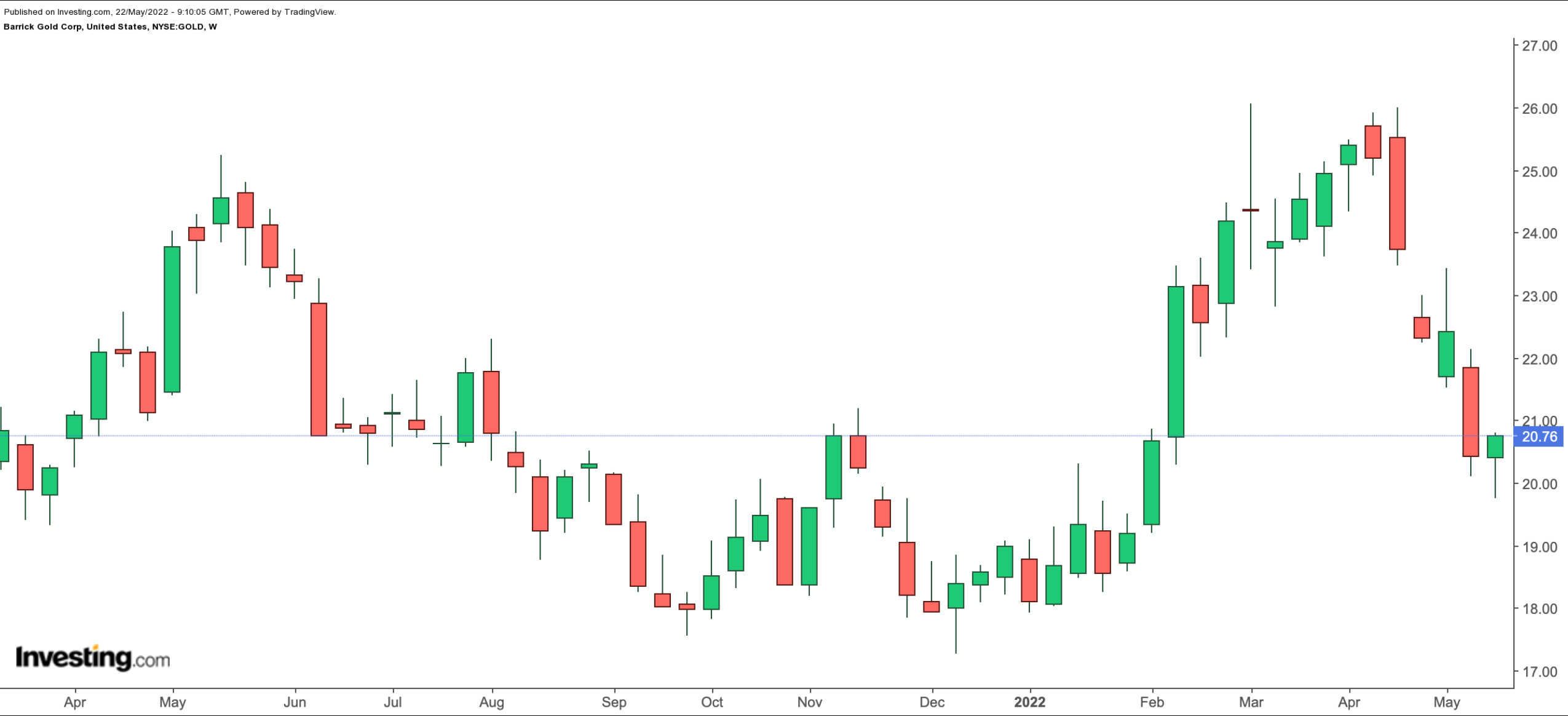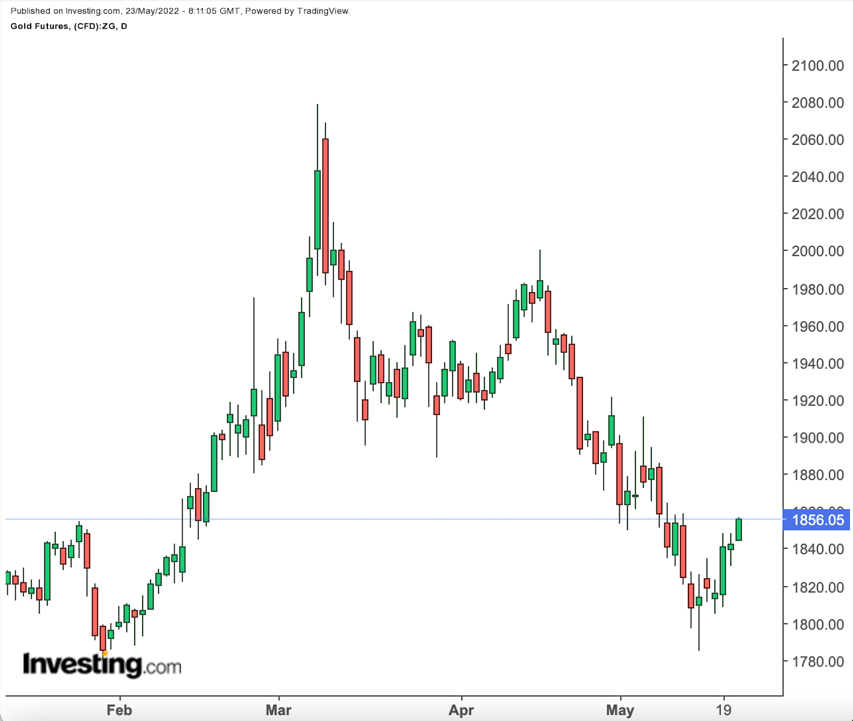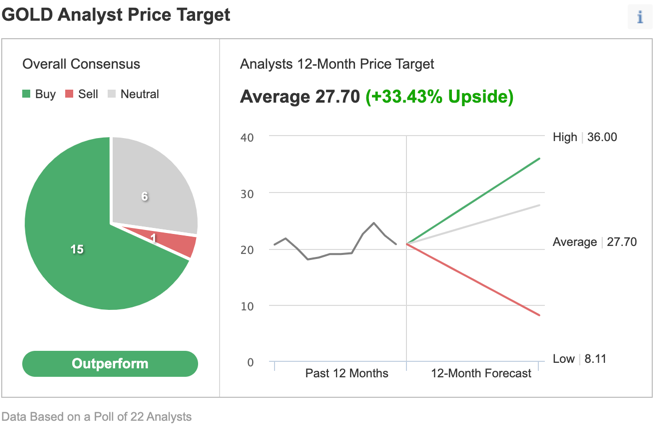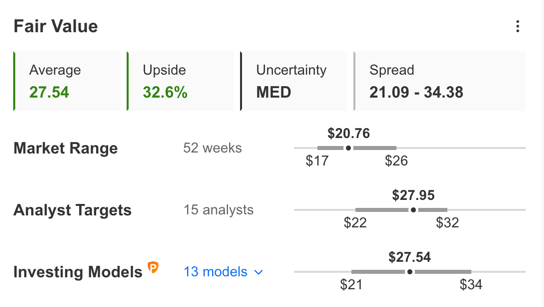- Shares of Barrick Gold have returned more than 9% since the start of the year
- The war in Ukraine and US interest rate hikes should continue to impact the gold price
- Buy-and-hold readers could consider investing in GOLD at current levels.
- For tools, data, and content to help you make better investing decisions, try InvestingPro
Shareholders of the Canadian miner Barrick Gold (NYSE:GOLD) have seen the value of their investment fall by almost 16% over the past 12 months. Yet, GOLD stock has appreciated over 9.2% year-to-date (YTD).
In comparison, the Dow Jones Precious Metals Index has gained less than 1% so far this year (making it roughly flat). Meanwhile, the S&P 500 is currently down more than 18% YTD.

On Mar. 8, when gold's price pushed through $2000 a troy ounce, GOLD stock also went over $26 to hit a 52-week high.
The stock’s 52-week range has been $17.27 - $26.07, and the market capitalization (cap) currently stands at $36.9 billion.
Through Barrick Gold, investors have exposure to price moves in gold and copper. The group owns a large portfolio of Tier 1 gold assets and copper mines in the industry, with operations in 18 countries.
Yet, for miners like Barrick, the price of gold represents not only a key growth driver but also a significant risk. So far in the year, the price of the shiny bullion is about flat, hovering shy of $1,850.
Increasing interest rates are typically bearish for gold. However, political uncertainties, like the war in Ukraine, and higher inflation typically lead to a bullish scenario for the precious metal.
Meanwhile, copper futures are trading around $4.30. As the world transitions to electric vehicles (EVs), many analysts have also become long-term copper bulls. Although GOLD stock is not a pure play on copper, management is looking to increase the industrial metal’s contribution to the bottom line.
How Recent Metrics Came
Barrick Gold released Q1 metrics on May 4. Management reported gold production of ~1.0 million ounces (oz.) and copper production of ~101 million pounds (lb.).
Quarterly revenue declined 3% year-over-year (YoY) to $2.85 billion. Adjusted net earnings per share came in at 26 cents compared to 29 cents a year ago. For the quarter, free cash flow (FCF) was $393 million.
On these results, CEO Mark Bristow stated:
“As guided earlier, Q1 was a softer quarter, particularly when compared to Q4 of 2021, which included a record-breaking performance from Nevada Gold Mines. With a stronger performance expected in the second half of the year, Barrick remains on track to meet its 2022 production guidance.”
Prior to the announcement of the Q1 result, GOLD stock was changing hands around $23. On May 20, GOLD stock closed at $20.76, down over 9.5%. Meanwhile, the current price supports a dividend yield of 1.93%.
What To Expect From GOLD Stock
Among 22 analysts polled via Investing.com, GOLD stock has an "outperform" rating, with an average 12-month price target of $27.70 for the stock.
Source: Investing.com
Such a move would suggest an increase of close to 33.4% from the current price. The target range stands between $36 and $8.11.
Similarly, according to a number of valuation models, including P/E or P/S multiples or terminal values, the average fair value for GOLD stock on InvestingPro stands at $27.54.

Source: InvestingPro
In other words, fundamental valuation suggests shares could increase more than 32.5%.
As part of the short-term sentiment analysis, it would be important to look at the implied volatility levels for GOLD options as well. Implied volatility typically shows traders the market's opinion of potential moves in a security, but it does not forecast the direction of the move.
GOLD’s current implied volatility is about 8% less than the 20-day moving average. In other words, implied volatility is trending lower while options markets suggest quieter trading days could be ahead.
Our expectation is for GOLD stock to build a base between $20 and $22 in the coming weeks. Afterwards, shares could potentially start a new leg up.
Adding GOLD Stock To Portfolios
Barrick Gold bulls who believe the current investing environment supports higher gold and copper prices could consider investing in GOLD stock now. Their target price would be $27.54, as per the target provided by fundamental models.
Alternatively, investors could consider buying an exchange-traded fund (ETF) that has GOLD stock as a holding. Examples include:
- VanEck Gold Miners ETF (NYSE:GDX)
- iShares North American Natural Resources ETF (NYSE:IGE)
- VanEck Natural Resources ETF (NYSE:HAP)
- VanEck Africa Index ETF (NYSE:AFK)
- First Trust BuyWrite Income ETF (NASDAQ:FTHI)
Finally, investors who expect GOLD stock to bounce back in the weeks ahead could consider setting up a covered call.
Most option strategies are not suitable for all retail investors. Therefore, the following discussion on GOLD stock is offered for educational purposes and not as an actual strategy to be followed by the average retail investor.
Covered Call On GOLD Stock
Price At Time Of Writing: $20.76
For every 100 shares held, the covered call strategy requires the trader to sell one call option with an expiration date at some time in the future.
Investors who believe there could be further choppiness and declines soon may use a slightly in-the-money (ITM) covered call. A call option is ITM if the market price (here, $20.76) is above the strike price ($20).
So, the investor would buy (or already own) 100 shares of GOLD stock at $20.76 and, at the same time, sell a GOLD July 15 $20-strike call option. This option is currently offered at a price (or premium) of $1.45.
An option buyer would have to pay $1.45 X 100 (or $145) in premium to the option seller. This call option will stop trading on Friday, July 15.
This premium amount belongs to the option writer (seller) no matter what happens in the future; for example, on the day of expiry.
The $20-strike offers more downside protection than an at-the-money (ATM) or out-of-the-money (OTM) call.
Assuming a trader would now enter this covered call trade at $20, at expiration, the maximum return would be $69, i.e., ($145-($20.76 - $20.00) X 100), excluding trading commissions and costs.
The trader realizes this gain of $69 as long as the price of GOLD stock at expiry remains above the strike price of the call option (i.e., $20 here).
At expiration, this trade would break even at the GOLD stock price of $19.31 (i.e., $20.76-$1.45), excluding trading commissions and costs.
On July 15, if GOLD stock closes below $19.31, the trade would start losing money within this covered call set-up. Therefore, by selling this covered call, the investor has some protection against a potential loss. In theory, a stock's price could drop to $0.
As we have noted in numerous articles, such a covered call would limit the upside profit potential. The risk of not participating in GOLD stock's potential appreciation fully would not appeal to everyone. However, within their risk/return profiles, others might find that acceptable in exchange for the premium received.
The current market makes it harder than ever to make the right decisions. Think about the challenges:
- Inflation
- Geopolitical turmoil
- Disruptive technologies
- Interest rate hikes
To handle them, you need good data, effective tools to sort through the data, and insights into what it all means. You need to take emotion out of investing and focus on the fundamentals.
For that, there’s InvestingPro+, with all the professional data and tools you need to make better investing decisions. Learn More »
